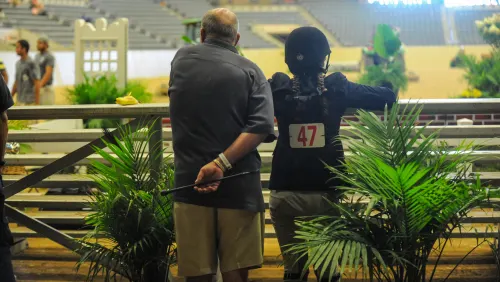One of my favorite aspects of showing hunters is being able to get all dressed up for a hunter classic, especially when it also coincides with a galloping outside course. There’s just something about wearing a stock tie and shadbelly that makes the day special. While I’ve chosen to wear an ASTM/SEI-approved helmet with my shadbelly, I’ve always thought a top hat really made the look. I guess it’s the old-fashioned elegance and tradition that I admire. And, although I understand the reasons behind the decision U.S. Hunter Jumper Association and U.S. Equestrian Federation leaders made in passing the rule requiring all riders jumping at recognized hunter/jumper shows to wear ASTM/SEI-approved helmets, I still feel melancholy about the change.
I read the three letters to the editor in last week’s Chronicle (p. 54) against the new helmet rule and found myself nodding in agreement with points made in all of them. As adults, shouldn’t we be able to make decisions for ourselves?
But it’s when our choices affect others negatively–such as higher liability and insurance rates, among others–that our freedom to choose becomes a conflict. And the costs involved when a person incurs a severe head injury are far-reaching–from financial and emotional distress for relatives and friends to even negative public relations for the sport. For me, that’s the gray area in which this helmet rule lies.
I can’t fault the USEF and USHJA leaders for wanting to increase the safety and well-being of their members. They believe that they’re doing the right thing. After all, other sports associations, such as the NFL and NASCAR, mandate certain safety gear for their participants, and we all know that equestrian disciplines are among the most dangerous sports. There are already numerous rules about what we must wear in the show ring–what’s one more?
ADVERTISEMENT
But, on the flip side, this rule does infringe on a person’s freedom of choice. There are professionals and amateurs who’ve been successfully riding, training and showing for decades without an organization mandating their headgear. Some believe wearing a harness is dangerous because in an accident the helmet may slide forward or backward, causing injury. And there are riders who wear custom-made helmets for a perfect fit, something not widely offered in ASTM/SEI-approved brands.
There are many reasons for choosing a particular style, brand and type of helmet, and for each person that choice is a personal one. As the daughter of a neurologist, I know all about head injuries and the devastation they can impart on a person and his or her family. When I began riding, back in the 1970s, times were different. Many adults (and children alike) didn’t wear helmets for day-to-day riding, and for showing your choice was a black or brown velvet hunt cap, sans harness.
At age 10, I was out on a trail ride and a group of deer spooked our horses. I fell off and tried to hold my horse’s reins. In fear, she pulled back, and when she couldn’t get away she ran forward, kicking me in the head. My helmet fell off when I hit the ground, providing no protection when she galloped over me. The repercussions of the concussion I received that day have been with me the rest of my life.
After that injury, I wore a helmet with a harness–and still do today. I never donned a top hat with my shadbelly, but I certainly didn’t condemn someone who did. It’s a beautiful tradition that I’ll miss seeing in the show ring–but for safety’s sake, I think the organizations made the right decision.














